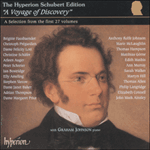
Welcome to Hyperion Records, an independent British classical label devoted to presenting high-quality recordings of music of all styles and from all periods from the twelfth century to the twenty-first.
Hyperion offers both CDs, and downloads in a number of formats. The site is also available in several languages.
Please use the dropdown buttons to set your preferred options, or use the checkbox to accept the defaults.

There is nothing of this kind in Als ich sie erröten sah; ‘the sweet sounds of the lyre’ here support a song which is just as much arioso as aria, and the emotions of rapture do not aspire to the driven energy of Gretchen am Spinnrade or the Müller songs. The music is ardent at the same time as being tentative and as shy as a blush. Because the song is a difficult one with long breaths it is all too easy to sing it in a hectoring manner absolutely inappropriate to the seemingly inexperienced lover who receives so much unworldly rapture from the glowing hue of a young lady’s cheek. The clue to the song’s performance are the words ‘Mit Liebes Affekt’ which stand at the top of the manuscript. Schubert is here using a baroque term which derives from Affektenlehre or ‘The Doctrine of the Affections’, a concept understood by older composers and performers such as Schubert’s German mentors Reichardt and Zumsteeg. Music was considered to be oration in sound, and the singer was encouraged to use his own taste to vary his performance in terms of tone, rhythm, contrast of emphasis, all in the pursuit of clear and interesting verbal delivery. This concept of Affekt has to be understood by the performers of Reichardt’s Lieder for example, where the notes on the printed page often seem wooden as if they are waiting to have life breathed into them by singer and pianist.
Als ich sie erröten sah is just such a song of the old school; it even looks like Reichardt’s music on the printed page. The singer is told to play the part (‘Mit Liebes-Affekt’) of a young man tenderly in love. In practical terms this calls for a flexibility of rhythm where the meaningful and loving declamation of the words is more important than the piano’s semiquaver underlay which is utterly different – supportive rather than organically integrated – from that of Gretchen am Spinnrade. In fact the nearest counterpart to this Ehrlich setting is not one of the celebrated Schubert songs but rather another one from 1815, An die Apfelbäume, wo ich Julien erblickte which is also in compound time with a long bel canto line unfolding over undulating semiquaver sextuplets. There are similar difficulties in the long phrases with scarcely a space to breathe, as well as the feeling that the metre of the poem is perhaps not best suited to the musical solution chosen for it. John Reed writes that the song has a ‘wonderful spontaneity and plasticity’ but it takes the intervention of the performers (and above all considerable skill on the part of the long-breathed singer) to avoid turning the piece into the merry scherzo which it appears to be at first glance.
Very little is known about the poet Bernhard Ambros Ehrlich beyond the fact that he was a reasonably high-ranking civil servant who lived and worked in Prague. Schubert found this poem in an anthology entitled Erstlinge unserer einsamen Stunden (‘The First Fruits of our Solitary Hours’) published in 1791.
from notes by Graham Johnson © 1994
 Schubert: The Complete Songs Schubert: The Complete Songs‘This would have been a massive project for even the biggest international label, but from a small independent … it is a miracle. An ideal Christ ... ‘Please give me the complete Hyperion Schubert songs set—all 40 discs—and, in the next life, I promise I'll "re-gift" it to Schubert himself … fo ...» More |
 Schubert: An introduction to The Hyperion Schubert Edition Schubert: An introduction to The Hyperion Schubert Edition'Irresistible!' (BBC Music Magazine) 'A delightful sampler' (The Penguin Guide to Compact Discs)» More |

